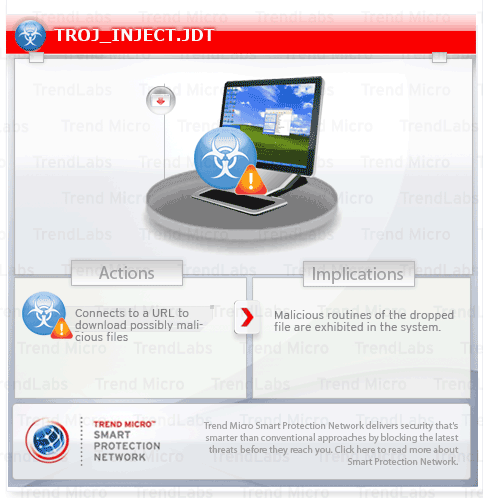TROJ_INJECT.JDT
Windows 98, ME, NT, 2000, XP, Server 2003


Threat Type: Trojan
Destructiveness: No
Encrypted:
In the wild: Yes
OVERVIEW
This {malware/spyware type} has received attention from independent media sources and/or other security firms.
To get a one-glance comprehensive view of the behavior of this Trojan, refer to the Threat Diagram shown below.

This Trojan may be downloaded by other malware/grayware from remote sites. However, as of this writing, the said sites are inaccessible.
TECHNICAL DETAILS
Arrival Details
This Trojan may be downloaded by the following malware/grayware from remote sites:
- JS_SHELLCOD.JDT
However, as of this writing, the said sites are inaccessible.
Installation
This Trojan drops the following copies of itself into the affected system:
- %User Temp%\mshmail.exe
- %User Temp%\svchost.exe
(Note: %User Temp% is the current user's Temp folder, which is usually C:\Documents and Settings\{user name}\Local Settings\Temp on Windows 2000, XP, and Server 2003.)
It drops the following files:
- %User Temp%\wshiph.dll
(Note: %User Temp% is the current user's Temp folder, which is usually C:\Documents and Settings\{user name}\Local Settings\Temp on Windows 2000, XP, and Server 2003.)
Autostart Technique
This Trojan adds the following registry entries to enable its automatic execution at every system startup:
HKEY_CURRENT_USER\Software\Microsoft\
Windows\CurrentVersion\Run
mshmail = %User Temp%\mshmail.exe -installkys
Download Routine
This Trojan accesses the following websites to download files:
- https://www.{BLOCKED}kor.com/asp/kys_allow_get.asp?name=getkys.dat
Other Details
Based on analysis of the codes, it has the following capabilities:
- This file may be executed using the following switches:
- removekys
- installkys
- It copies the creation date and time of the legitimate svchost.exe and uses it to set the following file's creation time:
- %User Temp%\svchost.exe
(Note: %User Temp% is the current user's Temp folder, which is usually C:\Documents and Settings\{user name}\Local Settings\Temp on Windows 2000, XP, and Server 2003.)
SOLUTION
6.913.00
11 Mar 2010
Step 1
For Windows XP and Windows Server 2003 users, before doing any scans, please make sure you disable System Restore to allow full scanning of your computer.
Step 3
Delete this registry value
Important: Editing the Windows Registry incorrectly can lead to irreversible system malfunction. Please do this step only if you know how or you can ask assistance from your system administrator. Else, check this Microsoft article first before modifying your computer's registry.
- In HKEY_CURRENT_USER\Software\Microsoft\Windows\CurrentVersion\Run
- mshmail = %User Temp%\mshmail.exe -installkys
- mshmail = %User Temp%\mshmail.exe -installkys
Step 4
Search and delete this file
There may be some component files that are hidden. Please make sure you check the Search Hidden Files and Folders checkbox in the More advanced options option to include all hidden files and folders in the search result.
- %UserTemp%\mshmail.exe
- %UserTemp%\svchost.exe
- %UserTemp%\wshiph.dll
Step 5
Scan your computer with your Trend Micro product to delete files detected as TROJ_INJECT.JDT. If the detected files have already been cleaned, deleted, or quarantined by your Trend Micro product, no further step is required. You may opt to simply delete the quarantined files. Please check this Knowledge Base page for more information.
Did this description help? Tell us how we did.

